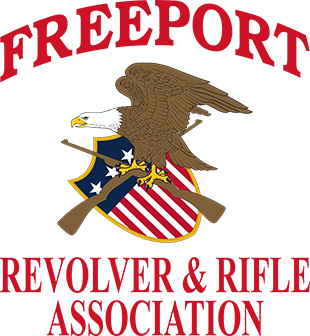Freeport NY R & R Association
RANGE SAFETY RULES
(Specific to this range only)
S A F E T Y starts by using good common sense. Think before you act! If you are
not sure of what you are about to do, then don’t do it!
1. Firearm Operation
Every member is responsible for knowing how the firearm operates before they are to fire it at the range. If you are not sure how everything works on the firearm you are about to use, then don’t use it. You are liable if you injure someone, or damage property. Read the instructions that came with the firearm. If you don’t have a copy, then write the manufacturer for one. Ask the person who sold you the firearm to explain all the operational features of it. If they can’t, then find someone who can before you attempt to fire it.
2. Safety, Security and Use of Firearms
You are responsible for the safety, security and use of your firearms, including all pertinent Federal, State and Local regulations and laws.
3. Eye and Ear Protection
Eye and ear protection will be worn by all who are firing a firearm or observing one firing it.
4. Making the Firing Line Safe
a. Before going forward of the firing line, guns are made safe by having the SLIDES BACK, MAGAZINES OUT, CHAMBERS EMPTY, CYLINDERS OPEN, BOLTS BACK and the EJECTION PORT VISIBLE FOR INSPECTION. Then place the gun on the bench with the muzzle pointing down range.
b. All shooters will step back behind the Firing Line. After the Range Officer checks the line, the command to go forward will be given.
c. Those people not going down range will remain behind the Firing Line.
d. While people are down range, there will be no handling of any firearms. On the Indoor Range there is a Safe Light that is turned on indicating that the line is safe for people to go forward. This light should be turned on before going down range and shut off when all have returned to the firing line.
5. Loading and Unloading Firearms
All Firearms shall be loaded and unloaded ONLY on the indoor and outdoor FIRING LINE. There are NO EXCEPTIONS TO THIS RULE!
6. Loaded Handguns Not on the Firing Line
Handguns shall be holstered and secured to your body. Unloaded handguns are to be placed in a case, not left in a holster lying around in public view.
7. Long Guns
Long guns shall be secured unloaded in a case. They are not to enter the range property loaded! Only .22 rimfire rifles may be used in the indoor range from any position except prone.
8. Smoking
There is No Smoking permitted in the indoor areas of the range.
9. Indoor Range
All shooting must be done from the 50 foot distance. Only Points 2, 3, 4 and 5 may be used for mid range shooting on targets no longer than 20”. Mid range is identified by a broad Red painted marking above the 21’ distance near the ceiling. Targets at Points 1 and 6 must only be used full range at the 50’ backstop. Only paper targets are to be used and firing is from shoulder height or sitting from a chair. There will be NO HIP or QUICK DRAW shooting. Prone shooting is allowed IF YOU ARE BEING SUPERVISED BY A RANGE OFFICER.
10. Outdoor Range
a. Covered Points
The regular covered firing line, points 1-20, is at the 25 yard line and has priority over all other firing lines. It has metal frames that can house a backer and target on furring strips. All shooters will fire at the same distance. Only one backer is allowed, Shooters provide their own furring strips, backer and targets. Only handguns and .22 rifles can be used on points 1-20.
b. Sand Pit Area
To the right of points 1-20 is the Sand Pit Area and it is used for firing all other firearms. No target in the Sand Pit Area shall have its top edge higher than 6 feet above the ground. No plinking, no glass or other fragmenting types of targets are allowed. Only reactive steel plates, self sealing or paper targets are allowed. Bow and arrow or shotguns with slugs may be used from the 25yd line in the sand pit area only, no bird shot. When you are finished shooting, remove your targets and brass.
11. Ammunition
a. Indoor Range
Standard pistol caliber lead or jacketed
No Magnum loads
No handguns in rifle cal. allowed. (i.e. .221, .223, 7/308, .30-30, 35 Whelen, etc.)
No cartridges over 1400 feet per second
No Black Powder firearms
b. Outdoor Range
On the target line where the metal frames are used, points 1-20, the same rules as section 11a above apply. In the Sand Pit Area you may use Magnum loads and handguns that can fire a bullet over 1400 F.P.S. NO ARMOR PIERCING AMMO OR TRACERS ALLOWED.
c. Duds (defective cartridges) are not to be left at the range nor placed in the trash cans at the range.
12. Gun Ready Room
The Gun Ready Room is for the cleaning and repair of unloaded guns and equipment. There are never to be any loaded firearms displayed or worked on in this room. All firearms are to be made safe on the indoor or outdoor firing line prior to being displayed or worked on in the Gun Ready Room. No ammo or firearms are to be left in the lockers.
